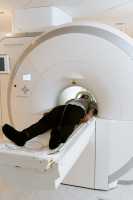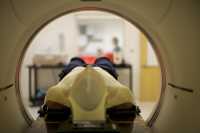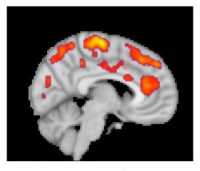Your Questions About MRIs Answered
The most important thing is to remember to stay relaxed and calm. You should not experience any pain during the...
MRI Study Revealed Ongoing Cardiac Inflammation in Patients Recovering from COVID-19
AI-Support Using Volumetric Biomarkers and Clinical Data Improves Diagnosis in MS, Autism and Alzheimer’s
Determining Brain Age Using AI and PET Imaging
Prostate Cancer: MRI-Ultrasound Fusion Technology Improves Biopsy Assessment During Active Surveillance
MRIs Improve Targeting of Biopsies for Prostate Cancer Diagnosis
Radiomics Plus Machine Learning Can Optimize Prostate Cancer Classification
Rheumatoid Arthritis: Study Finds No Benefit to MRI-Guided Treatment
Safety of MRIs in Patients with Tattoos
MedicalResearch.com Interview with:
Dr. Martina Callaghan PhD Head of Physics & Senior Lecturer Wellcome Centre for Human Neuroimaging Institute of Neurology University College London London
MedicalResearch.com: What is the background for this study? What are the main findings?
Response: As mirrors the situation in the general population, we found that an increasing number of volunteers who were seeking to enter cognitive neuroscience studies at our Centre had tattoos. However, the magnetic fields used in magnetic resonance imaging (MRI) pose a potential safety risk for people with tattoos. A number of case reports have described such incidents. However, as these describe isolated cases retrospectively, there was not enough information to objectively assess the risk of tattoo-related adverse reactions for persons having an MRI scan. Therefore, in 2011, we decided to embark upon this first prospective study to quantitatively assess this risk.
(more…)Newer MRIs May Predict Alzheimer’s Disease Before Any Symptoms
Fibromyalgia: Scan Reveals Increased Brain Activation in Pain, Emotion and Affect Areas
bpMRI Can Be Used to Improve Prostate Cancer Risk
MRI-Guided Prostate Biopsy Improves Precision Diagnosis of Cancer
- We knew that there were limitations in the standard of care pathway for the diagnosis of prostate cancer, TRUS biopsy which missed harmful cancers and over diagnosed harmless cancers.
- Emerging reports in the literature showed that using an alternative diagnostic pathway, MRI and MRI-targeted biopsy, showed promising prostate cancer detection rates
- In 2012 we set out in an international working group to design a study that could change clinical practice and replace the standard of care with a pathway involving MRI
PSMA PET/CT Can Map Prostate Cancer Recurrences With Very Low PSA Levels
 Jeremie Calais MD
Ahmanson Translational Imaging Division
UCLA Nuclear Medicine Department
Los Angeles, CA 90095
MedicalResearch.com: What is the background for this study? What are the main findings?
Response: The only curative treatment for recurrent prostate cancer after radical prostatectomy is salvage radiotherapy. Unfortunately, current standard imaging modalities are too insensitive to visualize the location of the recurrence until it is too late. As a result, salvage radiotherapy is directed to areas only suspected to harbor the recurrence based upon a "best guess" approach according to standard guidelines that define radiotherapy treatment volumes.
PSMA PET/CT is a new imaging technique with sensitivity sufficient to detect and localize the recurrent prostate cancer early enough to potentially guide salvage radiotherapy.
The first sign of prostate cancer recurrence is a rising PSA. For salvage radiotherapy to be successful, it should be initiated before the PSA rises above 1 ng/mL, and ideally, closer to 0.2 ng/mL or lower. PSMA PET/CT localizes sites of prostate cancer recurrence in up to 70% of patients with low PSA, below < 1.0.
In the US it is not yet FDA approved and currently only used for research purposes. In our current study we included 270 patients with early recurrence of prostate cancer after surgery from Germany and UCLA, we found that 20 % of the patients had at least one lesion detected by PSMA PET/CT which was NOT covered by the standard radiation fields. Obviously, salvage radiotherapy is only curative if recurrent disease is completely encompassed by the radiotherapy fields and would have failed in these patients.
(more…)
Jeremie Calais MD
Ahmanson Translational Imaging Division
UCLA Nuclear Medicine Department
Los Angeles, CA 90095
MedicalResearch.com: What is the background for this study? What are the main findings?
Response: The only curative treatment for recurrent prostate cancer after radical prostatectomy is salvage radiotherapy. Unfortunately, current standard imaging modalities are too insensitive to visualize the location of the recurrence until it is too late. As a result, salvage radiotherapy is directed to areas only suspected to harbor the recurrence based upon a "best guess" approach according to standard guidelines that define radiotherapy treatment volumes.
PSMA PET/CT is a new imaging technique with sensitivity sufficient to detect and localize the recurrent prostate cancer early enough to potentially guide salvage radiotherapy.
The first sign of prostate cancer recurrence is a rising PSA. For salvage radiotherapy to be successful, it should be initiated before the PSA rises above 1 ng/mL, and ideally, closer to 0.2 ng/mL or lower. PSMA PET/CT localizes sites of prostate cancer recurrence in up to 70% of patients with low PSA, below < 1.0.
In the US it is not yet FDA approved and currently only used for research purposes. In our current study we included 270 patients with early recurrence of prostate cancer after surgery from Germany and UCLA, we found that 20 % of the patients had at least one lesion detected by PSMA PET/CT which was NOT covered by the standard radiation fields. Obviously, salvage radiotherapy is only curative if recurrent disease is completely encompassed by the radiotherapy fields and would have failed in these patients.
(more…)Carbon Monoxide Poisoning: Acute Brain Lesions on MRI Can Predict Delayed Sequelae
 Won Young Kim, MD PhD
Department of Emergency Medicine
Asan Medical Center
University of Ulsan College of Medicine
Seoul, Korea
MedicalResearch.com: What is the background for this study?
Response: Neurological symptoms of carbon monoxide (CO) poisoning can manifest not only immediately but also as late as 2 to 6 weeks after successful initial resuscitation as delayed neurological sequelae (DNS). To date, no reliable methods of assessing the probability of DNS after acute CO poisoning have been developed, which make it difficult to research the pathophysiology of DNS and targeting prevention.
(more…)
Won Young Kim, MD PhD
Department of Emergency Medicine
Asan Medical Center
University of Ulsan College of Medicine
Seoul, Korea
MedicalResearch.com: What is the background for this study?
Response: Neurological symptoms of carbon monoxide (CO) poisoning can manifest not only immediately but also as late as 2 to 6 weeks after successful initial resuscitation as delayed neurological sequelae (DNS). To date, no reliable methods of assessing the probability of DNS after acute CO poisoning have been developed, which make it difficult to research the pathophysiology of DNS and targeting prevention.
(more…)High Rates of Amyloid Imaging Positivity in Patients With Primary Progressive Aphasia
Novel Brain Imaging May Detect Preclinical Alzheimer’s Disease
Brain Imaging Patterns Moving Closer To Identifying Schizophrenia on Functional MRI
MRI Biomarkers Track Cognitive Impairment Due to Head Trauma
MRI At Six Months Can Predict Which High Risk Babies Will Develop Autism
MRI Guided Prostate Biopsies Can Improve Care and Reduce Costs
Cardiac Magnetic Resonance Can Exclude Clinically Relevant Coronary Artery Disease
Ischemic Stroke: Collateral Blood Vessels Detected by Arterial Spin Labeling MRI Correlates With Good Neurological Outcome
Clinical Outcomes Following a Low-Suspicion MRI for Prostate Cancer
MedicalResearch.com Interview with: [caption id="attachment_32943" align="alignleft" width="180"] Dr. Boessen[/caption] Lars Boesen MD PhD Department of Urology Herlev Gentofte University Hospital Herlev MedicalResearch.com: What is the background...












